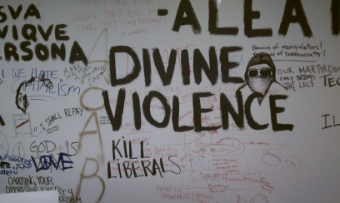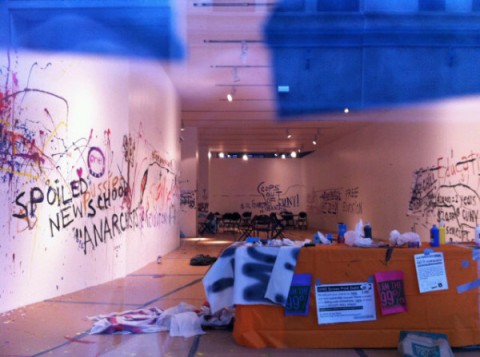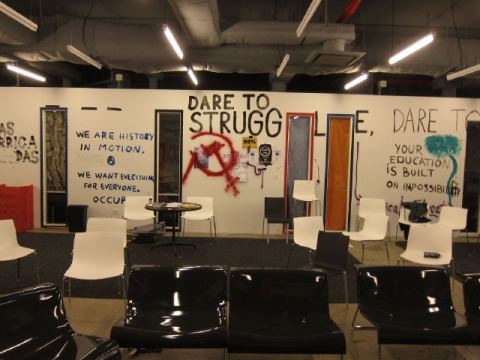
“The coming occupations will have no end in sight, and no means to resolve them. When that happens, we will finally be ready to abandon them.”
When we wrote that in December 2008 in New York City, after occupying a university building by Union Square, we were treated as youthful idealists, nihilist anarchists, even fascist thugs. What are your demands? they asked. But what are you for? they wondered. Occupy everything? they shrieked.
Alas. Our premonitions have come to pass.
It was only a matter of time. When the crisis first hit in the fall of 2008, its effects were diffuse, with individuals all over the country feeling it simultaneously, yet not collectively. Students, who have both the time to act and think free from the imperative to work, naturally reacted first. With an insurrection in Greece brewing, and a legitimation crisis of the American economy at hand, occupations without demands spread from New York to California, with thousands involved. Demands are irrelevant when no one can hear you, and so the only real demand was to occupy itself. Immature maybe, but not stupid. With foreclosures growing exponentially, and unemployment skyrocketing as well, occupying one’s space and means of living is the most obvious of actions. In the most unpolitical of Western democracies, one must first create a space for politics to emerge.
But students on their own are nothing. Especially left radical ones.
Always half way in and half way out of work, the student can only express frustration of what is to come, not what has been. Hence, the theoretical advantage of the current wave of occupations, which takes it starting point not as the looted future, but rather the broken present. From here, one no longer needs to “convince” others what “may” happen; rather, the present itself is cracking underneath everyone’s feet. And only those living in skyscrapers can avoid the initial fractures.
Occupy Wall Street and its subsequent multiplications follow the trajectory of American social struggle which began in the labor riots after the civil war and continued with punctuated equilibrium up unto the most recent flare ups in the anti-globalization protests of the early second millennium. What is this trajectory? Simply put, at the beginning of the refounded republic of America, the working population demanded shorter hours and better pay, with independent representation and collective bargaining rights. These specific demands, which sometimes merged and sometimes conflicted with demands for women’s suffrage and civil rights, were backed up with massive waves of violence: strikes, sit-downs, street battles, riots, looting, arson. While demanding specific guarantees for life by words, they demanded nothing from the destroyed factories and trains by deeds. The normal American citizen, the 99%, from Reconstruction to the Second World War, was baptized in blood and blessed with material gains. Citizen engagement in politics receded to the background of enjoying fresh commodities. With a relative peace gained for white working men, the sphere of political engagement opened to the other 99%, the black population. The slowly building postwar struggle for civil rights exploded in the 60’s, with not only demands for equal treatment and respect, but also demands for inclusion in the material gains which the white working population temporarily secured. These political and social demands voiced in Washington and Selma were only the small foreground to the colossal mute rage in the background which, when heard, shattered the merchandise filled windows of Newark, Detroit, LA, Oakland, Chicago, and almost every other inner-city neighborhood in America. The self-destruction of their own neighborhoods was the sign of having “nothing left to lose,” a political position which can’t but win.
As the movement for equality and civil rights crested, the youth and anti-war movements of the mid 60’s and early 70’s gained in strength. Taking the physical message of the race riots to heart—that there is no victory without struggle—the young radicals mixed early labor tactics with civil rights strategies, which blended into an ideology that asserted its right to own the fruits of American society. Everything was up for grabs, and everything shall be ours. The specificity of political movements in this period was in the nature of its general demands: freedom, equality, peace, everything.
But the struggle for a total demand broke in the mid 1970s, when the crisis of the American economy led to a renewed class assault on those who make the country run. This assault is ongoing. No longer could anything be given to those who demanded, no longer must business and government be beholden to its employees and citizens. This new relation between governing and governed, between owners and laborers, was called austerity. From this point on, the gains of the last century slowly receded. Real wages stagnating while prices increasing, income inequality exploding while unemployment rising, unimaginable wealth produced while unbelievably few own it—the American dream bought on bad credit, paid with a high interest rate, only softened by a coupon to the movie theatre. What can one demand when there’s nothing left to give?
“Not” having a demand is not a lack of anything, but a contradictory assertion of one’s power and one’s weakness. Too weak to even try and get something from those who dominate working life, and simultaneously strong enough to try and accomplish the direct appropriation of one’s soul, time, and activity apart from representation. A demandless struggle reveals the totality of the enemy one fights and the unity of those who fight it. Such a struggle “lays claim to no particular right because the wrong it suffers is not a particular wrong but wrong in general.” This ‘general wrong’ is the impersonal structure of exploitation at the heart of our economic system—the forced selling of one’s time and life activity to someone else in return for a wage—which can never be overcome by any particular change, only by a total one.
Yet the demandless struggle is not ‘radical’ because it has no demands, just as the struggle for better wages is not ‘reformist’ because it does. More important than the demands waged against power are the demanding responsibilities that the situation itself calls forth. What is specific about the current moment is the explicit recognition by people themselves in public, together, out loud, indefinitely, of their own condition in the conditions of others. In other words, people are materially recognizing themselves while mutually recognizing each other. The forms of these encounters, while spectacular, are nothing compared to their contents. The questions of work, money, community, family, sex, color, time, class, education, health, media, representation, punishment, and faith are no longer individual questions. To think any is to think through all, and to really think through all requires an occupation without end. Occupations without end are infinite and free, not because they are everywhere and last forever, but because there is nothing outside determining them but themselves. The overcoming of the occupations is the practical realization of such freedom, a task that can only be accomplished historically.
Take heed: there is a rationality at work here, a reason of social inferences which is made even more clear by the current lack of adequate concepts to understand it. The major premise of the 99% perfectly synthesizes the universal emptiness of the modern American, expressing fully its entire being without reference to one determinate quality. The truth of the occupations is not only in their substance, but in the subjects as well. The minor premise of occupation locates the subjects of the syllogism in a particular place and a particular time. Tied together through material relations of interdependency, one is compelled by logic to conclude that not even revolution is impossible.
The new era is profoundly revolutionary, and knows it. On every level of modern society, nobody can and nobody wants to continue as before. Nobody can peacefully manage the course of things from the top any longer, because it has been discovered that the first fruits of the crisis of the economy are not only ripe, but they have, in fact, begun to rot. At base, nobody wants to submit to what is going on, and the demand for life has now become a revolutionary program. The secret of all the “wild” and “incomprehensible” negations that are mocking the old order is the determination to make one’s own history.
Occupy Wall Street is the first major American response to the economic crisis of 2008. But the economic crisis of 2008 is the first major result to the failed response to the crisis of the 1970’s. In effect, the delayed class war of the last three decades, in which Americans with good faith gave businesses and government a generation to fix the problem, has emerged with a vengeance. The time for waiting is over. The age of austerity has hit its limit. Occupying everything without demands is only the first baby step in the gigantic shoes of the new American proletariat.
Q. Libet
October 2011













![dunnymetrocard[1]](https://reoccupied.files.wordpress.com/2010/03/dunnymetrocard1.jpg?w=480&h=679)





